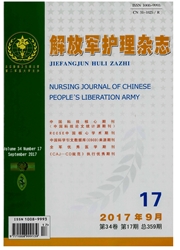

 中文摘要:
中文摘要:
目的观察并比较经周围静脉穿刺置入中心静脉导管(peripherally inserted central catheters,PICC)和经颈内静脉穿刺置入中心静脉导管(central venous catheter,CVC)两种置管途径在慢性心力衰竭(chronic heart failure,CHF)患者药物治疗中的应用特点,从而为临床护理提供依据。方法 2009年1-12月,将165例慢性心力衰竭患者按随机数字表法分为PICC组83例和CVC组82例,PICC组实施经肘部静脉行中心静脉置管,CVC组实施经颈内静脉行中心静脉置管,观察并比较两组患者置管操作所需时间、一次性置管的成功率、患者的自觉舒适度、与操作相关并发症的发生率以及导管相关性血流感染的发生率等。结果 CVC组患者的置管操作时间显著短于PICC组(P〈0.05),PICC组的1次置管成功率显著高于CVC组(P〈0.05);发生与置管操作相关并发症的发生率,PICC组低于CVC组,但差异无统计学意义(P〉0.05);导管相关性血流感染的发生率,PICC组显著低于CVC组(P〈0.05);患者自觉舒适度PICC组显著优于CVC组,差异有统计学意义(P〈0.05)。结论 PICC是CHF患者建立静脉通道的首选途径,CVC是CHF患者应急抢救的有效通道。
 英文摘要:
英文摘要:
Objective To observe and compare the applying effects between peripherally inserted central catheter(PICC) and central vein catheter(CVC) in the patients with chronic heart failure(CHF) so as to provide evidence for clinical application.Methods A total of 165 CHF patients from January to December 2009 were randomly divided into a PICC group(n=83) with jugular vein catheterization and a CVC group(n=82) with peripheral vein catheterization.Then comparisons were conducted on the operative time,one-time success rate of catheterization,self-comfort level of the patients,operation-related complications,catheter-related bloodstream infections between the two groups.Results The operative time of catheterization was significantly less in the PICC group than in the CVC group(P0.05).The one-time success rate of catheterization was significantly higher in the PICC group than in the CVC group(P0.05).The incident of catheterization-related complication was significantly lower in the PICC group than in the CVC group(P0.05).The incident of catheter-related bloodstream infections was significantly lower in the PICC group than in the CVC group(P0.05).The self-comfort level was significantly lower in the PICC group than in the CVC group(P0.05).Conclusion PICC is the first choice of the CHF patients to establish the vein access.While CVC is the preferred method for emergent CHF patients.
 同期刊论文项目
同期刊论文项目
 同项目期刊论文
同项目期刊论文
 期刊信息
期刊信息
